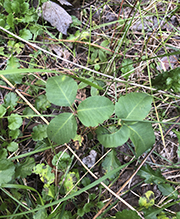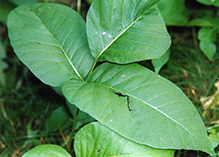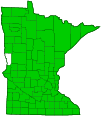western poison ivy
(Toxicodendron rydbergii)
Conservation • Weed • Wetland • Description • Habitat • Ecology • Use • Distribution • Taxonomy
|
|
|||||||||||||
Weed Status |
Specially Regulated Plant In 2010, the Minnesota Department of Agriculture added eastern poison ivy and western poison ivy to the Specially Regulated Plant list. Must be eradicated or controlled for public safety along rights-of-ways, trails, public accesses, business properties open to the public or on parts of lands where public access for business or commerce is granted. Must also be eradicated or controlled along property borders when requested by adjoining landowners. Poison ivy is beneficial to many wildlife species, but exposure to it causes severe skin irritation to humans and sometimes to livestock. Smoke from burning it can cause serious respiratory problems. |
Wetland Indicator Status |
|
Great Plains |
FACU - Facultative upland |
Midwest |
FAC - Facultative |
Northcentral & Northeast |
FAC - Facultative |
Description |
Western poison ivy is an erect, perennial shrub that rises on a single stem from a usually underground rhizome. It often forms colonies. The plant is usually a ground cover, sometimes a shrub, rarely a vine. If it is a vine it climbs weakly, and will not climb trees. Stems are woody, erect, usually unbranched, and lack aerial roots. Leaves are alternate and are borne near the end of the stem usually on leaf stalks. The leaf stalks are hairless and ½″ to 10″ long. The base of the leaf stem is enlarged and grooved. When the leaf is absent, a u-shaped or v-shaped scar remains. The leaves are divided into 3 leaflets. The leaflets may be egg-shaped, with the broad portion at the base where it attaches to the leaf stalk, or diamond shaped, broadest in the middle and tapering toward both ends. They taper to a point at the tip. They are 1″ to 6″ long. The two side leaflets are usually shorter than the central leaflet. The leaflet margins may have shallow lobes, they may have rounded teeth, or they may be entire. They tend to be folded slightly along the midrib, not flat. The upper surface is usually entirely hairless, or there may be a line of curly hairs on the midvein. The lower surface is either entirely hairless or has appressed hairs. In the spring the leaves are glossy and have a reddish tint. Throughout the year young leaves are shiny becoming dull with maturity. In the fall the leaves turn yellow to orange, rarely bronze to red. Black spots may appear on any part of the plant. The spots are urushiol, the resin that causes allergic reactions in humans. When the plant is damaged urushiol is exuded in an attempt to seal off the damaged area. The resin is creamy, turning brown-red then black with oxidation. The inflorescence is an elongated, 4″ to 16″ long, unbranched or sparingly branched cluster with usually fewer than 25 flowers. The flower has 5 yellowish petals. The fruit is a hairless, greenish-white, berry-like pome that turns ivory at maturity. It is distinctly ridged, “like a pumpkin”. The fruit cluster is compact and erect. |
Height |
Up to 60′ long |
Flower Color |
Yellowish |
Similar Species |
Boxelder (Acer negundo) saplings may have 3 (usually), 5 (occasionally), or 7 (rarely) leaflets. When it has 3 leaflets it can be indistinguishable from western poison ivy. Eastern poison ivy (Toxicodendron radicans ssp. negundo) is a vine, not a shrub. It climbs trees. The stems have aerial roots. The leaf stalks are densely hairy. The leaflets tend to be flat, not folded along the midrib. The inflorescence is 3″ to 4″ long. The fruit cluster hangs downward. |
Habitat |
Dry to moist. Wood edges, prairies, fences, beneath utility wires. Full shade to partial sun. |
Ecology |
Flowering |
June to August |
Pests and Diseases |
Poison ivy sawfly (Arge humeralis): First instar larvae skeletonize the leaves, eating the leaf tissue and leaving only the midrib and the main veins. |
Toxicity |
The sap of this plant contains the allergenic urushiol. Urushiol is not a single chemical but a complex of five chemicals called alkylcatechols. Several exposures to the substance may be necessary to impart sensitivity. Research has shown that 85% of all people will develop contact dermatitis after adequate exposure. It usually takes 12 to 48 hours for a rash to develop on a previously sensitized person. In some individuals, a single exposure will cause a reaction. In these individuals, the rash will develop in seven to ten days. The lesions last 14 to 20 days. Rashes do not spread and are not contagious. Treatment can dry the blisters, reduce the swelling, and relieve the itching, but it will not speed the healing. Contact with the outer surface on an undamaged plant should not cause an allergic reaction unless there is residual urushiol present from a previous injury to the plant or a nearby plant. Contact with a torn leaf, broken or damaged stem or rhizome, or black spot will cause a reaction in those sensitized to urushiol. Most wildlife are immune to urushiol, and poison ivy is an important food source for them. Many animals, including deer, black bears, muskrats, rabbits, and various birds, commonly eat poison ivy leaves, stems, and berries without any adverse reaction. |
Use |
|
Distribution |
||
|
Sources 2, 3, 5, 7, 8, 22, 24, 28, 29, 30. Biodiversity occurrence data published by: Minnesota Biodiversity Atlas (accessed through the Minnesota Biodiversity Atlas Portal, bellatlas.umn.edu, 6/9/2025). |
|
| 6/9/2025 | ||
Nativity |
||
Native |
||
Occurrence |
||
Common and widespread |
||
Taxonomy |
|
Kingdom |
|
Division |
Tracheophyta (Vascular Plants) |
Subdivision |
Spermatophytina (Seed Plants) |
Class |
|
Order |
Sapindales (soapberries, cashews, mahoganies, and allies) |
Family |
Anacardiaceae (cashew) |
Subfamily |
Anacardioideae (cashews, sumacs, and allies) |
Genus |
Toxicodendron (poison ivies and oaks) |
Subordinate Taxa |
|
|
|
Synonyms |
|
Rhus radicans var. rydbergii Rhus radicans var. vulgaris Rhus toxicodendron var. vulgaris Toxicodendron desertorum Toxicodendron radicans var. rydbergii |
|
Common Names |
|
northern poison-ivy Rydberg’s poison-ivy western poison ivy western poison-ivy |
|
Glossary
Entire
Continuous; not toothed, notched, or lobed.
Pome
A fruit with a central seed bearing core enclosed in thick flesh, e.g., an apple or pear.
Rhizome
A horizontal, usually underground stem. It serves as a reproductive structure, producing roots below and shoots above at the nodes.
Urushiol
Collectively, the five chemicals (alkylcatechols) in the sap of Toxicodendrons that cause allergic reactions in humans.
Visitor Photos |
||
Share your photo of this plant. |
||
This button not working for you? |
||
Dan W. Andree |
||
 |
||
… western poison ivy perhaps got too dry or something and changed fall color. Interestingly poison ivy does get fall color. I've seen it in the late summer and fall and of course a plant or two early in season like the one in the photo. |
||
 |
 |
|
Orange Virbia Moth on Western Poison Ivy |
||
|
||
Poison Ivy been chewed on. |
|
|
 |
 |
|
Look what was on poison ivy... This female regal fritillary I accidentally flushed her out of a denser area of prairie not even knowing one was there and she flew out and landed in a more open area and rested on a western poison ivy plant. She was a good sized female though hard to tell maybe in the photo but not much smaller in size than some monarchs. It was back in July 2024. I was trying to find out if the western regal fritillary been added to the threatened list but only found info on the proposal of that status. But anyway she was a nice big female and very healthy that day I seen her. |
Poison Ivy Berries... This is what they looked like in March at Frenchman’s Bluff SNA. |
|
Poison Ivy... With abundant rains etc. vegetation including poison ivy is flourishing in some areas. At Frenchman’s Bluff SNA is no exception. I took this photo because the plants weren’t all in big masses like some areas. Just to show the leaves of three better. Also sighted was a red and black Poison Ivy Sawfly. Interesting creature that looked almost other world like from some angles. The larvae of that species feeds on poison ivy which is a good thing as there is plenty of it in areas out there. |
 |
|
Poison Ivy.... I wasn’t sure just what it was but I knelt down to tie a shoe and my knee must have been on some and I got a itchy rash on it. I just washed my knee area and put some stuff for itch on it and it eventually went away. Had also noticed a few small red spots on my ankles that itched. Guessing the same thing. I looked it up and it appears to be poison ivy. It was at Frenchman’s Bluff SNA and seems to be in several different areas throughout that SNA. I have encountered other areas in some woodlands even certain weeds can cause itching. I have actually become immune to some types. The poison ivy irritation didn’t last that long and didn’t spread to any place else thankfully. But probably differs with each individual. I’ll be more careful where I kneel down to tie a shoe when out and about in certain areas. |
||
Luciearl |
||
 |
 |
|
 |
|
|
Nancy Falkum |
 |
Blooming Poison Ivy |
Scott Bemman |
 |
Wander Without Wifi |
||
 |
 |
|
Bill Reynolds |
||
 |
 |
|
MinnesotaSeasons.com Photos |
||
|
||
 |
 |
|
Colony |
Colony |
|
 |
 |
|
Plant |
Plant |
|
 |
 |
|
Plant |
Plant |
|
 |
 |
|
Inflorescence |
Inflorescence |
|
 |
 |
|
Leaves |
Leaves |
|
 |
 |
|
Leaves |
||
Black spots (urushiol) |
||
 |
||
Aboveground rhizome |
|
|

Slideshows |

Visitor Videos |
||
Share your video of this plant. |
||
This button not working for you? |
||
Wander Without Wifi |
SIBLEY STATE PARK - Minnesota. A PAINFUL FAIL! |
About
We thought we were going to show you the natural wonders of Sibley State Park, a park that has been around for over 100 years. However, Mother Nature had other ideas. Please subscribe if you like what you see on Wander Without Wifi. |
Other Videos |
||
Blue Asters, Red Ivy |
About
Published on Sep 15, 2012 Blue big leaf asters (Eurybia macophylla?) and red western poison ivy (Toxicodendron rydbergii) make their seasonal contributions to our autumnal colors. Photographed at the Turtle River State Park, North Dakota (15 September 2012). |
rhus toxicodendron |
About
Uploaded on Aug 13, 2011 albero |

Visitor Sightings |
||
Report a sighting of this plant. |
||
This button not working for you? |
||
| Dan W. Andree July 2025 |
Location: Frenchman’s Bluff SNA Orange Virbia Moth on Western Poison Ivy |
 |
| Dan W. Andree 6/23/2025 |
Location: Frenchman’s Bluff SNA Poison Ivy been chewed on. |
 |
| Dan W. Andree March 2025 |
Location: Frenchman’s Bluff SNA This is what they looked like in March at Frenchman’s Bluff SNA. |
 |
Luciearl |
Location: Fairview Twp, Cass County |
 |
Luciearl |
Location: Fairview Twp, Cass County |
 |
| Nancy Falkum 6/7/2015 |
Location: Kellogg Weaver Dunes SNA, Weaver Dunes Unit Blooming Poison Ivy |
 |
| Scott Bemman 9/15/2020 |
Location: McCarthy Beach State Park |
 |
| Wander Without Wifi 9/15/2020 |
Location: McCarthy Beach State Park |
 |
| Bill Reynolds 6/1/2014 |
Location: Pennington Co MN |
 |
| Bill Reynolds 10/11/2013 |
Location: Pennington Co MN |
 |
MinnesotaSeasons.com Sightings |
||

|
Created: Last Updated: © MinnesotaSeasons.com. All rights reserved. |






